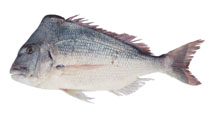| Family: |
Sparidae (Porgies) |
| Max. size: |
80 cm TL (male/unsexed) |
| Environment: |
demersal; marine; depth range 1 - 450 m |
| Distribution: |
Indian Ocean: including the Red Sea and Persian Gulf, to Singapore and southernmost end of the Malay Peninsula. |
| Diagnosis: |
Dorsal spines (total): 11-13; Dorsal soft rays (total): 9-10; Anal spines: 3-3; Anal soft rays: 7-8; Vertebrae: 24-24. This species is distinguished from all its congeners by the following set of characters: body deep and becoming compressed and less deep with growth; D XII,10, the first 2 dorsal-fin spines rudimentary (2 dorsal-fin spines on first dorsal pterygiophore); the dorsal-fin with two morpho types of configuration (Type I 'rigid type', fragile] as a rigid tapering spine and Type II ['flexible type', comparatively robust] as a flexible tapering spine in Group A - Red Sea, Group B - Gulf of Aden and eastern coast of Africa, and Group C - Persian Gulf, only Type II, is seen in both Group D - Madagascar to Sri Lanka and Group E - Eastern Indian Ocean, each Group is allopatric and is likely to have similar genetic structure (not analyzed in Group D or E). Colouration: body uniform pink with belly and lower jaw silvery, head red; spinous dorsal fin pink or red, other fins pink or pale pink; with pink tinge around eye; upper jaw often pinkish; anterior and posterior margins of the upper cheek scales nearly parallel just below rear edge of eye; orbit diameter is clearly less than suborbital depth (Ref. 124569). |
| Biology: |
Found in a wide range of bottoms. Young fish occur in very shallow waters of sheltered bays; larger individuals in deeper water. Feed on benthic invertebrates, mainly mollusks (Ref. 5213). Important food fish. |
| IUCN Red List Status: |
Least Concern (LC); Date assessed: 02 December 2009 Ref. (130435)
|
| Threat to humans: |
harmless |
Source and more info: www.fishbase.org. For personal, classroom, and other internal use only. Not for publication.

